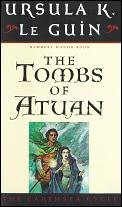
| Series: | Earthsea #2 |
| Publisher: | Simon Pulse |
| Copyright: | 1970, 1971 |
| Printing: | January 2003 |
| ISBN: | 0-689-84536-7 |
| Format: | Mass market |
| Pages: | 180 |
While The Tombs of Atuan does stand by itself fairly well, the depth of the story is aided in a few places by knowing what happens in A Wizard of Earthsea. I recommend reading that book first.
My memory from the first reading years ago told me that this was the best book of the original Earthsea trilogy, and I was gratified to discover that my memory didn't disappoint. If anything, it's better than I remembered.
This is the story of a young girl, taken as a child by a religious sect as the high priestess reborn of the Nameless Ones. It is the story of her life there, of how she grows into her role, of the woman that she becomes, and of how she reacts when someone comes from outside of her world to challenge everything she was taught. It is, in short, a coming of age story nearly as full of archetypes as A Wizard of Earthsea, but told in a way that I found far more engaging.
Le Guin is an exceptional writer, and with a single setting on which to lavish her skill, she builds a sense of place that runs remarkably deep. With sparse, evocative descriptions, a mere 180 pages creates a stronger feel of location than I've felt in far longer books, and I think part of the key is what she doesn't describe. The places that are important to Tenar stand out in the writing, while the places that don't matter to her fade into the background even if they are part of her day-to-day experience. The reader's attention isn't squandered on unimportant detail, and instead the distant background is left to fill in itself while the story concentrates on its heroine.
Unusually, Tenar is allowed to have power in her own sphere even before she comes of age. So often in coming of age stories, nothing that happens to the hero before they are discovered by the great events of the world really matters; they're just biding time before they become powerful and prophesied. Tenar, however, truly is the priest of her gods. While she knows nearly nothing of the world, Le Guin recognizes that if one is trained one's whole life for a function, one does actually become quite good at it even if young. Tenar knows her gods, understands their holy places, and takes initiative from early in the story to become better at what she thinks her role should be. This gives her far more influence over the outcome of the story, making it less something that simply happens to her.
It also allows for a far more realistic aftermath. Many lesser writers have halted this story earlier, after the obvious climax, but Le Guin goes on to write another 25 pages that bring to a beautiful second climax Tenar's emotional journey. I was engrossed by the entire book, but I fell in love with the ending.
Contrasting this story with A Wizard of Earthsea reveals much about what styles of storytelling work best for me. Wizard is a travelogue, showing bits and pieces of many places without enough for any location except Gont to really feel complete to me. I like Le Guin's descriptions much better when more focused, giving her a chance to slowly build up the feel of a single place. The narrative tone in Tombs is also much closer, letting the reader see how Tenar feels and reacts, letting us get some sense of what is going on inside her head, while Ged always remains distant in Wizard, his emotions described as part of the legend but not truly felt. Tombs touched me on a far more personal level, making me care deeply about the character and cry at her pain. (Partly, this is also because I think Ged makes a stronger supporting character than viewpoint character. He has a certain inscrutableness and quiet inwardness that I find more approachable when seen through the eyes of someone else.)
The Tombs of Atuan tells a story that I have a particular liking for, with a main character of a mold that I love. I'm not sure the story would feel as strong or strike as close to home to those of other tastes (although even with that caveat, I have to flatly disagree with the reviews that call this the weakest of the trilogy). It is, regardless, a story beautifully told, with more subtlety and nuance than innumerable stories more than twice its length. I highly recommend it.
Followed by The Farthest Shore.
Reviewed: 2004-12-07